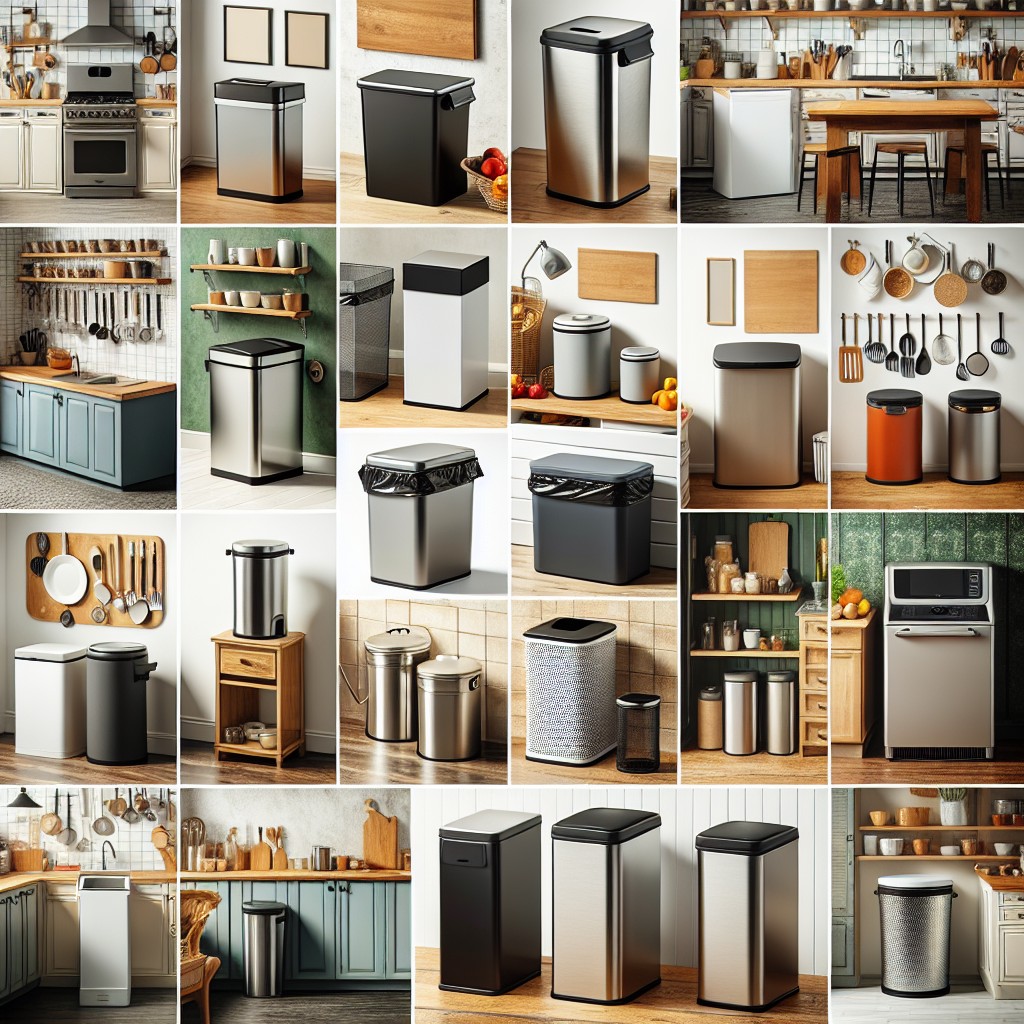Last updated on
Unpacking the topic of average kitchen trash can size becomes pivotal because it influences not only how efficiently your kitchen space is used but also the overall ease of managing and disposing kitchen waste throughout the week.
Selecting the right size for your kitchen trash can is more than a mere afterthought; it’s an essential decision that enhances the functionality and flow of one of the busiest rooms in your home.
Whether you’re navigating the demands of a large family’s waste or aiming for culinary greatness, each tidbit and turnover in your lifestyle plays a role in determining the ideal waste bin size—ranging from a compact 7 gallons to a robust 30 gallons.
With considerations such as available space, recycling preferences, and daily trash output, this concise guide will help ensure that the can you choose not only fits snugly into its designated nook but also aligns perfectly with your home life rhythm, all while being impeccably suited for the trash bags you’ll be tucking into it.
Key takeaways:
- Daily waste output determines can size.
- Larger families or frequent cooks need bigger cans.
- Consider kitchen space, recycling habits, and lifestyle.
- Optimal sizes range from 7 to 30 gallons.
- Choose trash bags that match can size.
What's Inside
What Size Trash Can Is Right For Your Home & Kitchen?

Selecting the ideal trash can size involves balancing your household’s waste output with the available space in your kitchen. Consider these points:
1. Daily Waste Output: A smaller household typically generates less waste, making a can around 7-10 gallons sufficient. Larger families or those who cook often may need a 12-16 gallon can.
2. Frequency of Trash Disposal: If you prefer to take out the trash less frequently, opt for a larger can. Conversely, if you don’t mind daily disposal, a smaller can will do.
3. Kitchen Space: Measure the area where you plan to place the trash can. Allow for clearance for lids or foot pedals. If the kitchen is tight on space, consider slim designs or those that fit under the sink.
4. Lifestyle and Cooking Habits: Those who recycle or compost may require a smaller can for non-recyclable waste. If you frequently host or have a high volume of kitchen activity, a larger can could prove more practical.
By considering each of these factors, you’ll ensure the trash can you choose meets both your needs and fits comfortably in your home environment.
Factors Influencing Kitchen Trash Can Size

Selecting the perfect trash can size is a practical decision influenced by several factors:
1. Household Size: Larger families typically produce more waste, necessitating a larger bin.
2. Cooking Frequency: Frequent cooking increases the amount of kitchen waste, influencing the size needed.
3. Recycling Habits: Diligent recyclers may find they generate less non-recyclable waste, allowing for a smaller trash can.
4. Available Space: The kitchen’s layout determines how much room you have for a trash can and therefore its size.
5. Lifestyle Preferences: Personal preference regarding how often the trash is taken out can dictate the ideal size – those preferring less frequent disposal might opt for a larger can.
6. Local Waste Management Regulations: Some localities have specific requirements for waste disposal that could affect the size and type of trash can you should use.
7. Ease of Handling: Consider how easy it is to remove a full bag; larger cans may become too heavy when full, especially for people with limited strength or mobility.
By considering these factors, you can make an informed decision on the trash can size that best fits your kitchen and lifestyle.
Standard Kitchen Trash Can Sizes
Navigating the array of sizes, kitchen trash cans commonly range from 7 to 20 gallons. The compact 7-gallon variety suits less frequented areas or single occupants, while the 20-gallon option caters to larger families or high-use kitchens.
A 13-gallon can is the sweet spot for most households, balancing capacity with space economy. This size is compatible with standard 13-gallon trash bags, which are readily available in most stores.
Before choosing, consider the size of your kitchen and the volume of trash you typically accumulate. Remember, a can that’s too large may lead to odors from waste sitting too long, while one too small could result in overflow and more frequent bag changes.
Some models offer extra features like foot pedals, automatic lids, or space-saving shapes for a snug fit against counters or in corners, enhancing both functionality and kitchen layout.
Estimating Trash Generation By Household Size
Anticipating the amount of waste your household produces is key to selecting the ideal trash can size. Here’s how typical family sizes measure up:
- Single-person homes: With less overall waste production, a small can of 7-10 gallons is usually sufficient.
- Two-person households: For these households, it’s often advisable to opt for a medium-sized can ranging from 12-16 gallons.
- Families of three to four: A larger capacity of 20-30 gallons will accommodate the increased waste output.
- Five or more individuals: Consider a can that holds 30 gallons or more to ensure that trash disposal needs are met without the bin overflowing.
Remember, lifestyle and cooking habits also impact waste generation. Frequent entertainers or home cooks might need larger bins, even in smaller households. By estimating trash generation effectively, you can ensure that your kitchen remains orderly and hygienic.
Space Considerations for Kitchen Trash Cans
Maximizing floor space while maintaining a functional kitchen is key when choosing your trash can size. Consider these pointers:
1. Cabinet Placement: Tucking a trash can under the sink or in a pull-out cabinet helps to utilize existing spaces efficiently.
2. Foot Traffic Flow: Ensure your trash can does not impede movement. Measure the area to guarantee there’s enough room to walk by when the can is accessed.
3. Opening Mechanism: Account for the space needed for lids that swing open or slide out. Overhead cabinets may restrict top-opening cans.
4. Corner Accessibility: A corner spot can be ideal for a trash can, but make sure it is easily reachable and doesn’t block cabinet doors.
5. Vertical Space: In tight kitchens, consider taller, slimmer cans that use vertical space wisely without taking up much floor area.
By being mindful of these aspects, you maintain a functional kitchen without letting the trash can dominate the landscape.
How to Measure for the Right Trash Can Fit
Ensuring adequate clearance is essential when fitting a trash can into your kitchen. Start by measuring the height, width, and depth of the desired location. Allow for at least three inches of extra space on all sides, so the can is easily removable and the lid can open fully without obstruction.
Consider the swing of cabinet doors or appliances that may impact where the can will sit. For pull-out bins, measure the interior dimensions of the cabinet, and account for the clearance needed for rails or hardware.
Remember that a compact space may require a slimmer, taller can, whereas a larger kitchen can accommodate a wider bin. Take note of any under-sink plumbing when measuring for a trash can in that location to avoid blockages or difficult fits.
Keep a tape measure handy, and write down measurements before shopping to ensure you select the right size for your space and needs.
Recommended Sizes for Different Household Sizes
Selecting the optimal kitchen trash can size hinges on the number of people that make up your household:
- One or Two People: A smaller can, around 7-10 gallons, should suffice for less waste production.
- Three to Four People: A medium-sized can, in the range of 12-16 gallons, is typically adequate to accommodate the increased waste.
- Five or More People: A larger can of 20-30 gallons will be necessary to manage the greater volume of trash generated.
Compact households may benefit from a smaller bin that allows for more frequent emptying, reducing odors and saving space. Conversely, larger families may prioritize a bigger bin to handle more waste, ensuring they aren’t taking out the trash too frequently. Remember to weigh the available space against the need to dispose of waste efficiently when making your decision.
Compatibility With Trash Bags and Liners
Selecting the correct size trash bags for your kitchen trash can is crucial to avoid the common frustrations of bags that are too small or too large. Here are some key points for a perfect fit:
1. Gallon Capacity: Match your trash can’s gallon capacity with the same size trash bag. A 13-gallon trash can requires 13-gallon bags.
2. Bag Dimensions: Look for bags that list dimensions (length x width) and compare them with your trash can’s measurements. This ensures the bag will fit snugly around the rim and have enough length to fold over the top.
3. Bag Thickness: Heavier-duty bags are less prone to rips and tears, particularly important if your trash tends to be on the heavier or bulkier side.
4. Drawstrings and Handles: Some bags come with these features for easier tying and carrying. If convenience is key for you, opt for bags that include them.
5. Special Liners: Some trash cans have proprietary liners. While they guarantee a perfect fit, generic bags can often be a more cost-effective solution.
Remember, trying out a few different brands may be necessary to find the best fit and performance. Keep an eye on how the bag handles being filled and lifted to ensure optimal compatibility.
Space-Saving Solutions for Small Kitchens
Maximizing kitchen space is crucial for functionality and ease of movement. A pull-out trash can tucked within a cabinet drawer makes waste disposal accessible without the can encroaching upon your limited floor area. Consider a trash can that mounts to the inside of a cabinet door for even more efficient use of space, perfect for tight spots and under the sink placement.
Another ingenious design is the trash can that doubles as a kitchen island, providing a surface for meal prep while concealing waste bins below. For exceptionally small spaces, slim and tall trash cans offer a smaller footprint with adequate volume for daily refuse.
Alternatively, hanging bins can be temporarily attached to drawer edges or countertop ends during food preparation, freeing up floor space and making clean-up a breeze. When not in use, these can be stored away easily.
Lastly, for those seeking to maintain a minimalistic look, recessed or built-in units blend seamlessly with kitchen aesthetics, keeping waste out of sight without taking up precious floor real estate.
Selecting the right space-saving solution not only helps maintain a clutter-free kitchen but also contributes to an organized and efficient home environment.
FAQ
What is the most common size kitchen trash can?
The most common size for kitchen trash cans is typically between 12 and 16 gallons, with 13-gallon being the most prevalent.
How tall is a 13 gallon trash can?
A 13 gallon trash can typically measures 14.9 x 17.2 x 25.5 inches.
Is 32 gallon trash can enough?
A 32-gallon trash can would be sufficient if your weekly trash production is around three tall kitchen garbage bags, but for larger quantities, you may want to consider a 60 or 90-gallon trash can.
What is a full size trash can?
A full-size trash can refers to an indoor 13-gallon can for daily waste management, or an outdoor extra-large 32-gallon trash can for storing accumulated waste or disposing large objects like yard debris.
How much waste can a 50-liter kitchen trash can hold?
A 50-liter kitchen trash can can hold approximately 50 kilograms of waste given that 1 liter typically equates to 1 kilogram of waste.
What are the dimensions of a 20-gallon kitchen trash can?
A 20-gallon kitchen trash can typically measures around 28.25 inches in height, 15.75 inches in width, and 16 inches in depth.
How often should the average kitchen trash can be emptied?
The average kitchen trash can should ideally be emptied at least once a day.




